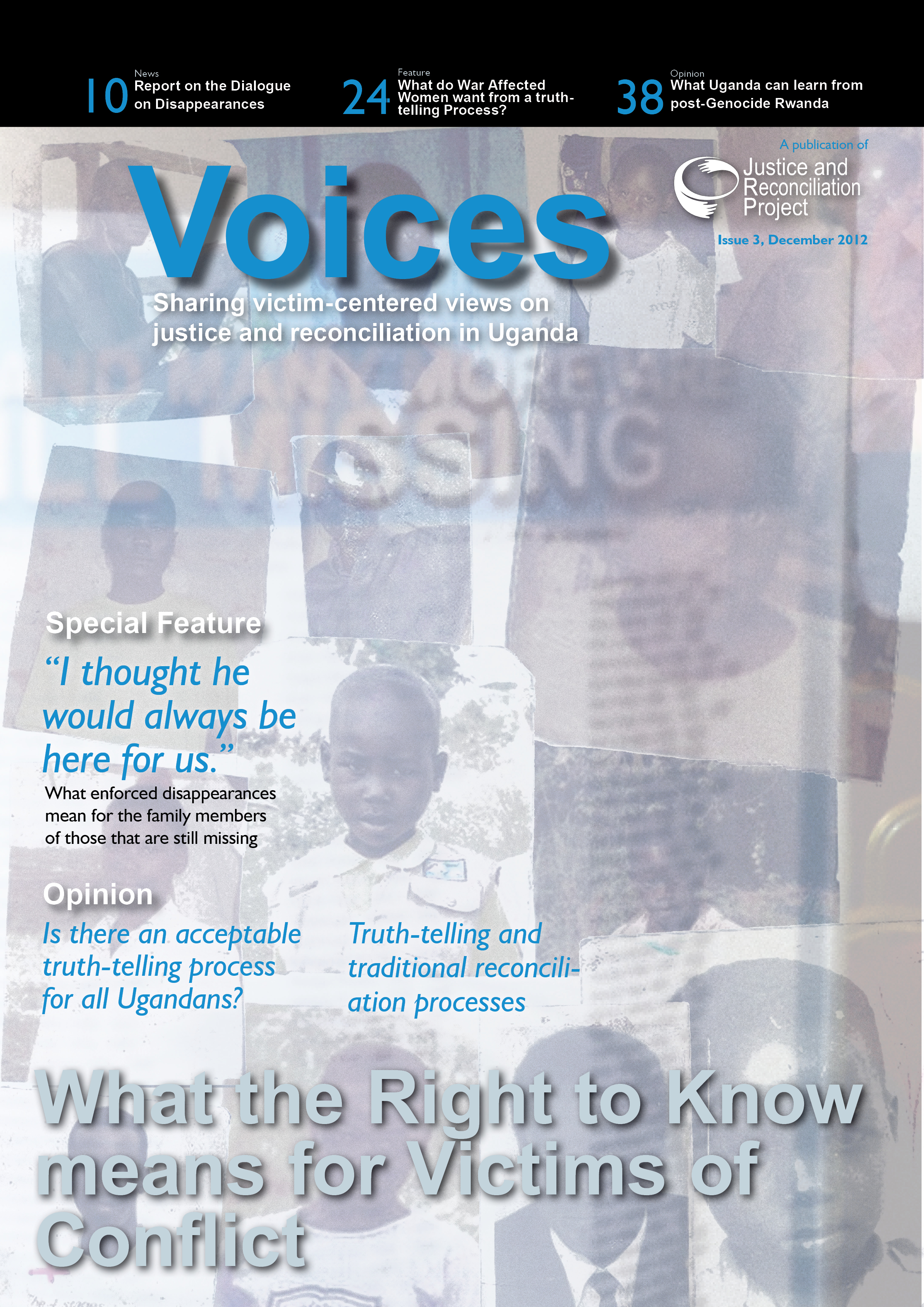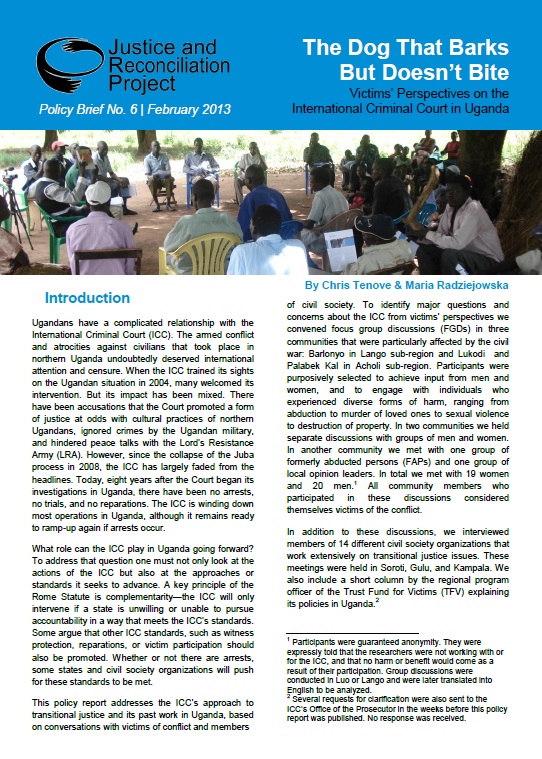
Kate Lonergan
In 1994, “Robert”, then 8 years old, was living in his uncle’s home. Late one night, the LRA attacked the home and abducted Robert. As the rebels were taking him, Robert was forced to watch one of the commanders, who was scarcely older than himself, brutally beat and kill his uncle. For the first week of his captivity, Robert and the commander moved as part of the same battalion. Soon, though, they were separated.
Robert eventually escaped from the LRA in 1999 and found his way to a World Vision reception center in Gulu. A few weeks later, the same commander arrived at the reception center and was placed into Robert’s living group. One night, a quarrel between the two boys turned into death threats.
“Do you know who I am?” the commander yelled, “There are many spirits that disturb me. If they come to me now, I could just kill you!”
Robert, fearing the commander’s threats, went to a World Vision counselor for help. World Vision staff brought the two boys together and asked them each to tell their side of the story. The commander narrated the events of the night he abducted Robert and killed his uncle. The commander then explained that he threatened Robert in order to protect himself from retribution for that incident, and asked Robert to forgive him. Initially, Robert was very upset, but he later returned and said to the commander, “There is no talk, I have forgiven you. Let us live freely.”
Reflecting on this experience years later, Robert says, “The only way so that you forgive your friend, you the perpetrator should start showing forgiveness at first. This means that you the perpetrator should come guiltily and humbly before the person who felt the pain of that act.”
Robert, like many other youth and women across Northern Uganda, felt strongly that knowing the truth about the commander’s actions against his uncle was a necessary prerequisite for forgiveness and reconciliation.
Amidst the relative peace that Northern Uganda now enjoys, many former LRA combatants like Robert and the commander must grapple with the delicate process of reintegrating into their community. This already challenging process is further complicated by the fact that many ex-combatants committed atrocities against friends, family members, and neighbors throughout the LRA’s reign of terror. As was the case for Robert, many victims must interact daily with individuals who caused them or their family members serious harm. These constant reminders of conflict experiences often create significant underlying tension in community relationships.
As part of an ongoing project on the experiences of women and youth with traditional justice practices, JRP’s Documentation department discussed current strategies for forgiveness, recovery and reconciliation with female and youth ex-combatants and victims of LRA attacks throughout the Acholi sub-region of Uganda. Through these discussions, we came to see the important role that truth-telling processes play in creating space for forgiveness and reconciliation at a local level in Northern Uganda.
Although almost all of our respondents expressed a strong desire for forgiveness and reconciliation, many cited the importance of an explicit exchange where the individual perpetrator requests forgiveness from the victim. Although both parties may live alongside each other without noticeable animosity, most people agreed that a clear apology was necessary in order to foster genuine forgiveness. As one woman reflected, “Such a person [who harmed me] should first of all beg for forgiveness from me…[w]hen a person admits and begs for forgiveness, there is nothing to stop me from forgiving such a person.”
Truth-telling comes as an important precursor to the process of admitting wrongdoing and asking for forgiveness. An individual must first explain and acknowledge his or her actions in order to ask for forgiveness.
Truth-telling also provides a way for ex-combatants to explain to victims the circumstances under which a crime occurred. This is particularly important in Northern Uganda, where abducted combatants were forced to commit terrible atrocities against their will. The process of declaring publically that they did not kill of their own free will is an important opportunity for the returned combatant to establish a positive identity separate from his or her actions during the conflict. One formerly abducted youth reflected, “Our voice can be heard when we unite with people in the community. When they start telling me about the bad things I did from the bush, then I tell them it was not my interest. The reason I did that, I was just like a messenger who is sent to go and do this.”
Much of the stigmatisation of returned LRA fighters stems from fear of their violent experiences during the conflict. An opportunity to establish the truth–that they were forced into violence and killing–helps to mitigate the fear of fellow community members that violence will recur in peace time.
While understanding that a crime was committed unwillingly will not lessen the painful memories or continuing struggle from the loss or injury, it can help improve victims’ relationship with the person who committed the crime. Hearing in detail how an LRA soldier was forced to kill can shift the blame from the individual to the organisation or commander who orchestrated the larger attack. This may allow the victim to forgive the individual who he or she must live and interact with in the community on a regular basis.
Of course, despite the integral role of truth-telling and apology in facilitating forgiveness, any truth-telling process must also address the potential negative consequences of sharing previously unknown details about horrific acts of violence committed during the conflict. As a formerly abducted youth in one community expressed, “If you see that there is abuse, you will not say all those things. […] There are some things I have never mentioned to anyone, not even my mother. If life gets more easy then I will say it, when fear disappears from my heart.” Without comprehensive support to combat stigmatization and facilitate positive relationships beyond the moment of truth-telling, a truth process carries the danger of further entrenching stigmatisation.
Despite the potential challenges of exposing painful truths about atrocities committed during the conflict, a systematic and public truth-telling process is an important part of the transitional justice process in Northern Uganda. A public process would provide an essential catalyst for apology and forgiveness that must occur in order to foster genuine healing and reconciliation. Although truth-telling already happens within communities and between neighbors, those who come forward to tell the truth face significant challenges. There is often minimal support in the process of confronting the victim, especially for former combatants lacking the strong family support system that would traditionally be used to initiate a process of truth-telling and apology. Creating a platform to facilitate this process in a safe and structured way will encourage more people to feel comfortable sharing the truth about their conflict experiences, which in turn will allow more opportunities for apology, forgiveness, and healing. ▪
Kate Lonergan is an intern with JRP’s Documentation Department.













